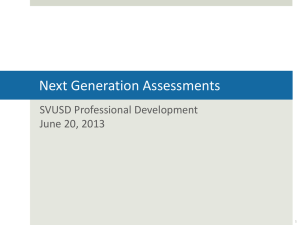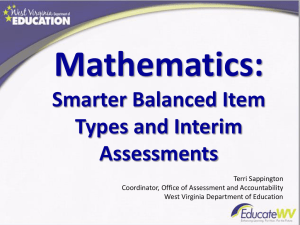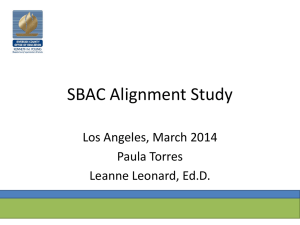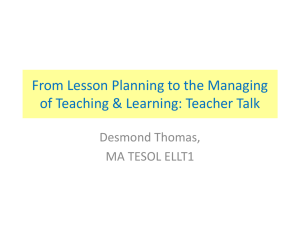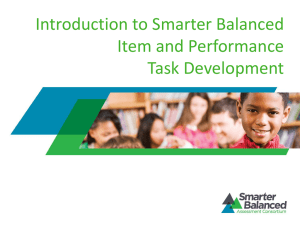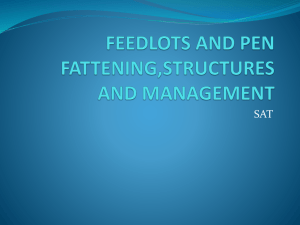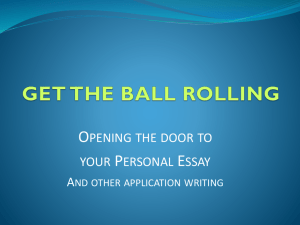Performance tasks
advertisement
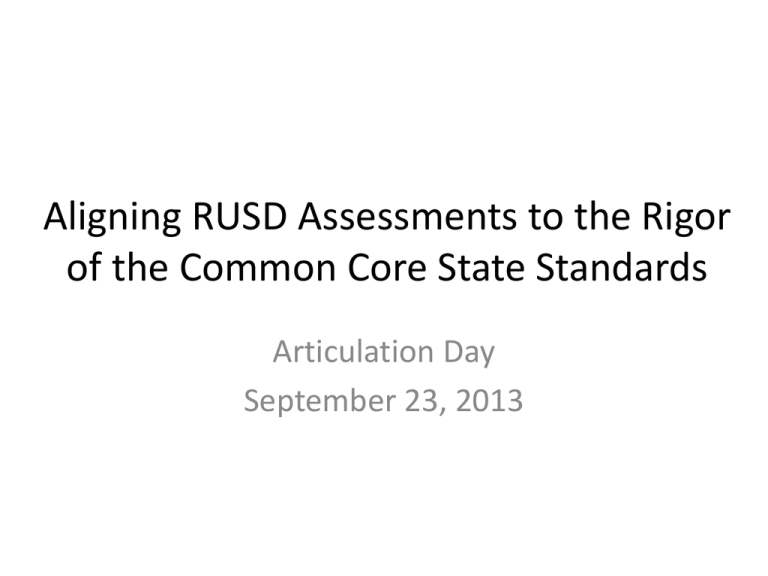
Aligning RUSD Assessments to the Rigor of the Common Core State Standards Articulation Day September 23, 2013 Reconceptualizing assessment without at the same time reconceptualizing instruction will have little benefit. Pullin, 2008 Norms • (ADD YOUR SITE SPECIFIC NORMS HERE) • Focus on content of the session. Burning questions about logistics of administering computer tests post on “Parking Lot” chart to be collected and addressed at a later meeting. Outcomes: • Participants will understand the role of summative, interim and formative assessment in the Smarter Balanced Assessment Consortium (SBAC) assessments. • Participants will understand the RUSD transition plan to SBAC. • Participants will understand the skills, concepts and knowledge necessary to succeed in the first pilot SBAC item to be administered in ELA and mathematics classes this fall. Smarter Balanced Assessment Consortium: A National Consortium of States • 28 states representing 44% of K-12 students • 21 governing, 7 advisory states • Washington state is fiscal agent The Purpose of the Consortium • To develop a comprehensive and innovative assessment system for grades 3-8 and high school in English language arts and mathematics aligned to the Common Core State Standards, so that... • ...students leave high school prepared for postsecondary success in college or a career through increased student learning and improved teaching A Balanced Assessment System Summative assessments Benchmarked to college and career readiness Common Core State Standards specify K-12 expectations for college and career readiness All students leave high school college and career ready Teachers and schools have information and tools they need to improve teaching and learning Teacher resources for formative assessment practices to improve instruction Interim assessments Flexible, open, used for actionable feedback Comprehensive Assessment System The Smarter Balanced Assessment System English Language Arts/Literacy and Mathematics, Grades 3 – 8 and High School* Last 12 weeks of year** DIGITAL LIBRARY of formative tools, processes and exemplars; released items and tasks; model curriculum units; educator training; professional development tools and resources; scorer training modules; and teacher collaboration tools. INTERIM ASSESSMENT Computer Adaptive Assessment and Performance Tasks INTERIM ASSESSMENT Computer Adaptive Assessment and Performance Tasks PERFORMANCE TASKS •ELA / Literacy • Math Scope, sequence, number, and timing of interim assessments locally determined Optional Interim assessment system — no stakes COMPUTER ADAPTIVE ASSESSMENT ELA/Literacy & Math Re-take option available Summative assessment for accountability Source: ETS – K12 Center * Summative and interim assessments for grades 3 – 8 and 11, with additional supporting assessments for grades 9 and 10. ** Time windows may be adjusted based on results from the research agenda and final implementation decisions. Summative Assessments • Mandatory comprehensive assessment in grades 3 – 8 and 11 that supports accountability and measures growth • Assesses the full range of CCSS in English language arts and mathematics • Computer adaptive –Selected response, short constructed response, technology enhanced • Performance tasks –One for reading, one for writing –Two for mathematics Using Computer Adaptive Technology for Assessments Faster results • Turnaround in weeks compared to months today Shorter test length • Fewer questions compared to fixed form tests Increased precision • Provides accurate measurements of student growth over time Tailored to student ability Greater security Mature technology • Item difficulty based on student responses • Larger item banks mean that not all students receive the same questions • GMAT, GRE, COMPASS (ACT), Measures of Academic Progress (MAP) Interim Assessments • Optional comprehensive and content-cluster (benchmark) assessment • Computer adaptive • Selected response, short constructed response, technology enhanced, and performance tasks • Available for administration throughout the year • Designed to provide multiple data points across time and can inform decisions at both the classroom and the school or district level. • Performance tasks provide an opportunity to challenge students to apply their knowledge and skills to respond to complex, real-world problems. Digital Library for Teachers SBAC Digital Library: Currently being developed by teachers from each member state Formative Assessment tools, processes and exemplars Professional Development Resources Released Items and Tasks Scorer training modules Model Units of Study Teacher collaboration tools Take the SBAC Pilot Practice Test http://sbac.portal.airast.org •Select blue box = "Training Test" •Select "Student" •Select "Training Test" •Click "Sign In" •Select a grade from the drop down menu and then click on "yes" •Select either the ELA or Math assessment •Click "Select •Click "Yes, Start My Test" •Click "Begin Test Now" Reflect Given the format of the new Smarter Balanced Assessment Consortium tests, what are the implications for my instruction? Six Item Types • • • • • • Selected Response Constructed Response Extended Response Performance Tasks Technology-Enabled Technology-Enhanced Selected Response Single Response – Multiple Choice Many experts will tell you that television is bad for you. Yet this is an exaggeration. Many television programs today are specifically geared towards improving physical fitness, making people smarter, or teaching them important things about the world. The days of limited programming with little interaction are gone. Public television and other stations have shows about science, history, and technical topics. Which sentence should be added to the paragraph to state the author’s main claim? A. Watching television makes a person healthy. B. Watching television can be a sign of intelligence. C. Television can be a positive influence on people. D. Television has more varied programs than ever before. Selected Response Multiple Correct Options Which of the following statements is a property of a rectangle? Select all that apply. Contains three sides Contains four sides Contains eight sides Contains two sets of parallel lines Contains at least one interior angle that is acute Contains at least one interior angle that is obtuse All interior angles are right angles All sides have the same length All sides are of different length Constructed Response The table below shows the number of students in each third-grade class at Lincoln School. Students in Third-Grade Class Number of Students Mrs. Roy 24 Mr. Grant 21 Mr. Harrison 22 Ms. Mack 25 There are 105 fourth-grade students at Lincoln School. How many more fourth-grade students than third-grade students are at Lincoln School? Show or explain how you found your answer. Constructed Response Extended Response Ms. McCrary wants to make a rabbit pen in a section of her lawn. Her plan for the rabbit pen includes the following: • It will be in the shape of a rectangle. • It will take 24 feet of fence material to make. • Each side will be longer than 1 foot. • The length and width will measure whole feet. Part A Draw 3 different rectangles that can each represent Ms. McCrary’s rabbit pen. Be sure to use all 24 feet of fence material for each pen. Use the grid below. Click the places where you want the corners of your rectangle to be. Draw one rectangle at a time. If you make a mistake, click on your rectangle to delete it. Continue as many times as necessary. Pen 1: Length: Width: Area: (feet, square feet) (feet, square feet) (feet, square feet) Pen 3: Length: Width: Area: (feet, square feet) (feet, square feet) (feet, square feet) Pen 2: Length: Width: Area: (feet, square feet) (feet, square feet) (feet, square feet) Part B Ms. McCrary wants her rabbit to have more than 60 square feet of ground area inside the pen. She finds that if she uses the side of her house as one of the sides of the rabbit pen, she can make the rabbit pen larger. • Draw another rectangular rabbit pen. • Use all 24 feet of fencing for 3 sides of the pen. • Use one side of the house for the other side of the pen. • Make sure the ground area inside the pen is greater than 60 square feet. Use the grid below. Click the places where you want the corners of your rectangle to be. If you make a mistake, click on your rectangle to delete it. Use your keyboard to type the length and width of each rabbit pen you draw. Then type the area of each rabbit pen. Be sure to select the correct unit for each answer. [Students will input length, width, and area for each rabbit pen. Students will choose unit from drop down menu.] Use your keyboard to type the length and width of each rabbit pen you draw. Then type the area of each rabbit pen. Be sure to select the correct unit for each answer. Length: Width: Area: (feet, square feet) (feet, square feet) (feet, square feet) Performance Task Student Directions: Part 1 (35 minutes) Your assignment: You will read a short story and article, watch a video, review research statistics, and then write an argumentative essay about your opinion on virtual schools. Steps you will be following: In order to plan and compose your essay, you will do all of the following: 1. Read a short story and article, watch a video, and review research statistics. 2. Answer three questions about the sources. 3. Plan and write your essay. Directions for beginning: You will now read the sources and watch a video. Take notes, because you may want to refer back to your notes while writing your essay. You can refer back to any of the sources as often as you like. • (short story) • (article 1) • (video) • (research statistics) Questions Use your remaining time to answer the questions below. Your answers to these questions will be scored. Also, they will help you think about the sources you’ve read and viewed, which should help you write your essay. You may click on the appropriate buttons to refer back to the sources when you think it would be helpful. You may also refer to your notes. Answer the questions in the spaces provided below them. 1. Analyze the different opinions expressed in “The Fun They Had” and the “Virtual High School Interview” video. Use details from the story and the video to support your answer. 2. What do the statistics from “Keeping Pace with K–12 Online Learning” suggest about the current trends of virtual schools in the U.S.? Use details from the charts to support your answer. 3. Explain how the information presented in the “Virtual High School Interview” video and the article “Virtual Schools Not for Everyone” differs from the information in the research statistics? Support your answers with details from the video and the articles. Part 2 (85 minutes) You will now have 85 minutes to review your notes and sources, and to plan, draft, and revise your essay. You may also refer to the answers you wrote to the questions in part 1, but you cannot change those answers. Now read your assignment and the information about how your essay will be scored, then begin your work. Your Assignment Your parents are considering having you attend a virtual high school. Write an argumentative essay explaining why you agree or disagree with this idea. Support your claim with evidence from what you have read and viewed. Technology-Enhanced Selected or Constructed Responses that include Multimedia Opportunities and Challenges SBAC aims to support a transition to a “balanced” assessment system. What are the opportunities and challenges for RUSD in transitioning to SBAC? Constructed Response #1 ELA and Math • September 23: Deconstruct the task • October 18: Closing date for administering 10-item Checkpoint #1 and Constructed Response #1 (reminder: SBAC Pilot Items are not included in Checkpoint results for 2013-2014) • October 28: Review student work samples together with team and calibrate scoring at Articulation Day PART A: Complete with team on September 23 with the constructed response item you will administer in October PART B: Administer the constructed response item before October 18 PART C: Review student work samples together on October 28. You will also calibrate scoring on this date. SBAC Pilot Constructed Response #1 Complete the task with a partner. SBAC Pilot Constructed Response #1 Discuss solutions or responses with your teacher team. SBAC Pilot Constructed Response #1 Brainstorm knowledge, concepts and skills students must know to successfully complete the task. Student Work Protocol 3) 10 minutes - discuss the following question: Having deconstructed this task, what implications are there for my instruction? What implications are there for instruction in Science, Social Studies, World Languages, Electives and other courses?
